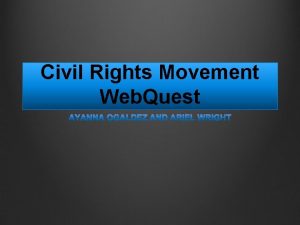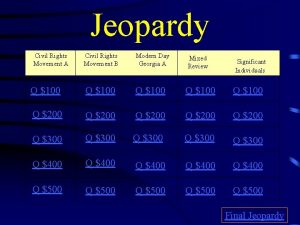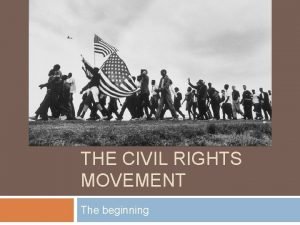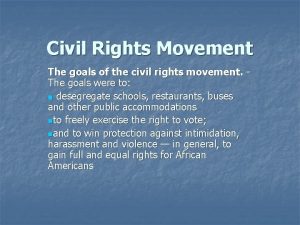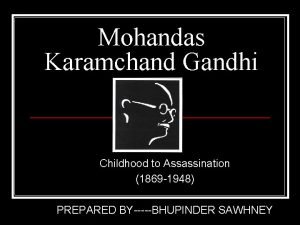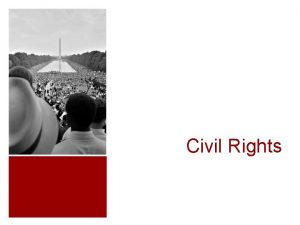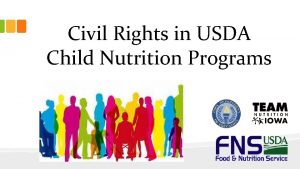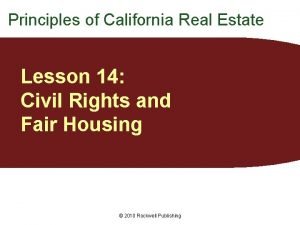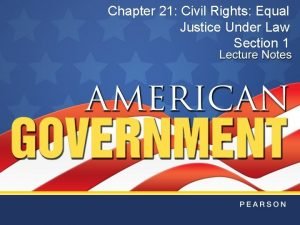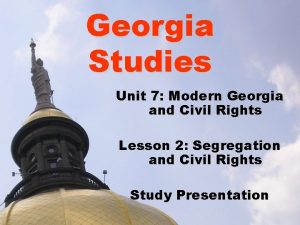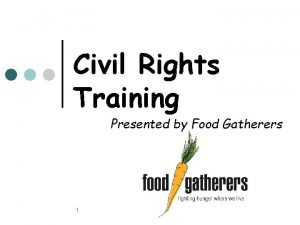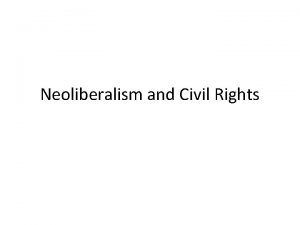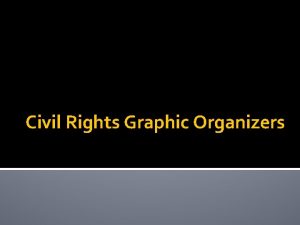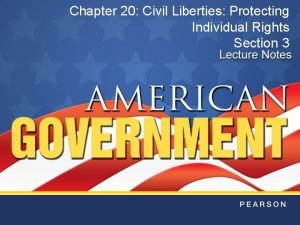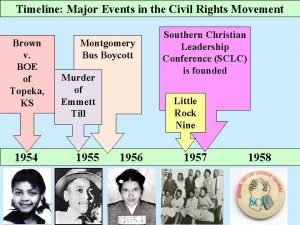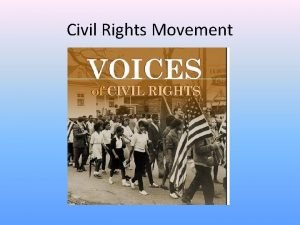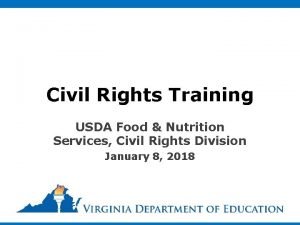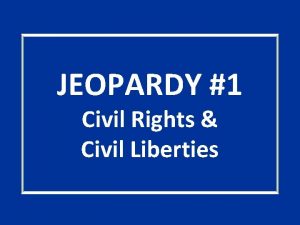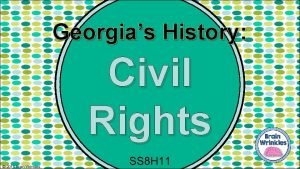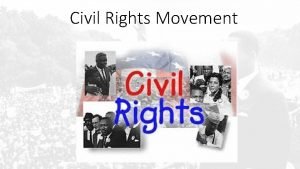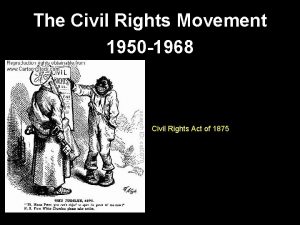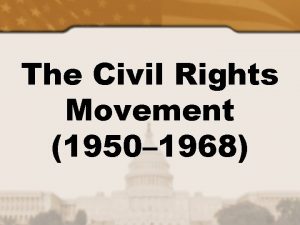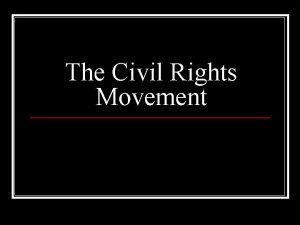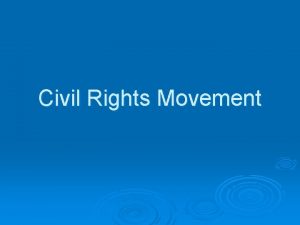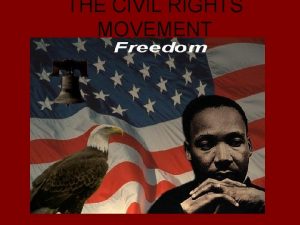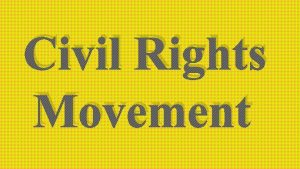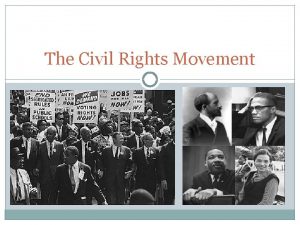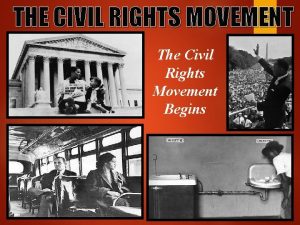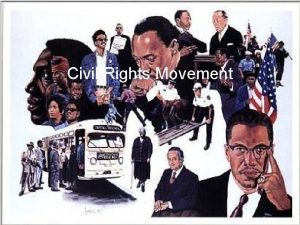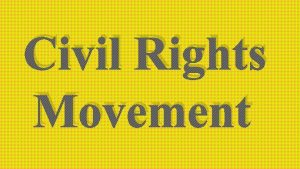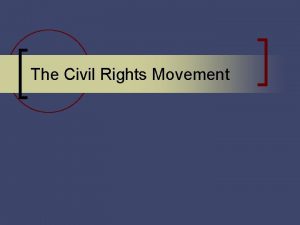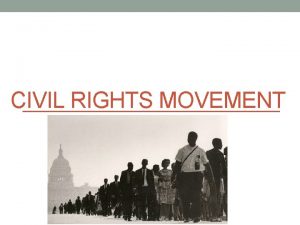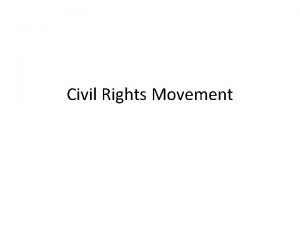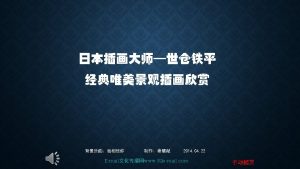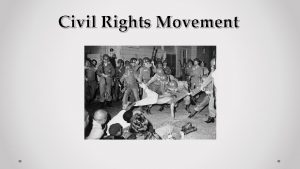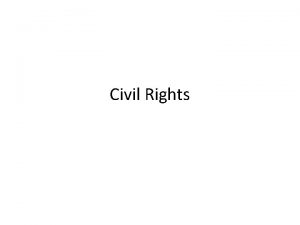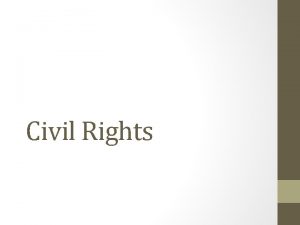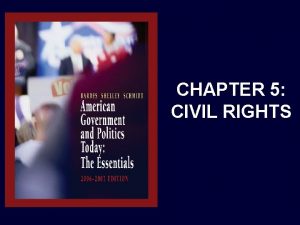The Civil Rights Movement 1950 1990 Civil Rights



























- Slides: 27

The Civil Rights Movement 1950 -1990

Civil Rights Movement • Jackie Robinson • Plessey v. Ferguson • Brown v. The Board of Education • Thurmond Marshall • NAACP • Rosa Parks • Dr. Martin Luther King • March on Washington • Voting Rights Act of 1965 • Little Rock, Arkansas, 1957 • 24 th Amendment • Sit-ins and Freedom Rides in the South, 1960 -61 • Civil Rights Act of 1964 • 26 th Amendment • Affirmative Action 1965 • Black Power • Malcolm X • Woman’s Liberation Movement • Betty Friedam • Cesar Chavez

Movement for Equality • Jackie Robinsonbecame the first African-American baseball player to cross the “color line” and join the major leagues.

Plessey v. Ferguson • Was a landmark United States Supreme Court decision approving racial segregation in in public facilities, ruling that states could prohibit the uses of public facilities by African American.

Jim Crow Laws • Were a series of laws mostly in the Southern United States that restricted most rights of African American granted after the Civil War. The laws required black and white people to use separate water fountains, public schools, public bath houses, restaurants, public libraries, and rail cars in public transport.

National Association for the Advancement of Colored People • NAACP is one of the oldest and most influential civil rights organizations n the United States.

Brown v. Board of Education of Topeka Kansas • Was a landmark case of the US Supreme Court (1954) which outlawed de jure racial segregation of public education facilities, ruling that “separate but equal” in public education could never provide black American with equal education available to white Americans. Brown not only overturned the case Plessey v. Ferguson but also provided the legal foundation of the Civil Rights Movement of the 1960 s.

Racial Segregation • Is characterized by forced separation of people of different races in daily life when both are doing equal tasks, such as eating in a restaurant, drinking from a water fountain, using a restroom, attending school, going to the movies, or in the rental or purchase of a home. Segregation may be de jure ( Latin, meaning “by law”)-mandated by law-or de facto (also Latin, meaning “in fact”); A de facto may range by racial discrimination in hiring and in the rental and sale of housing to vigilante violence such as lynching.

Southern Manifesto • Was a document written in 1956 to opposed racial integration in public places. The document was drawn up to counter Brown, which integrated public places.

Montgomery Bus Boycott • Was a political protest campaign started in 1955 in Montgomery, Alabama intended to oppose the city’s policy of racial segregation on its public transit system. After a year of boycott, the Supreme Court declared illegal the Alabama laws

Southern Christian Leadership Conference • Is a civil rights organization founded in 1957. It was headed by Martin Luther King Jr. The organization focused on non-violent civil disobedience and believed that it could use that to gain the civil right that African American lacked in the time. Prominent members of the organization included the Revered Al Sharpton, Jesse Jackson and Andrew Young.

Freedom Riders • Were a group of men and women from many different backgrounds and races who boarded buses, planes and trains and headed to the deep South to test the 1960 US Supreme Court ruling outlawing racial segregation in all public facilities. African American who disobeyed the state’s segregation laws were arrested and fined.

Selma to Montgomery Marches • Were marches that marked the political and emotional peak of the American civil rights movement. The marches were made for voting rights. In 1965, 600 civil rights marchers were attacked by state and local police with billy clubs and tear gas.

Civil Rights Act of 1964 • Outlawing discrimination based on race, color, religion, sex or national origin. It prohibited discrimination in public facilities, in government, and in employment. The Jim Crow laws in the South were abolished, and it was illegal to segregation of the races in schools, housing, or hiring.

Voting Rights Act of 1965 • Outlawed the requirement that would be voters in the US take literacy test to qualify to register to vote, and it provided for federal registration of voters, instead of state or local registration.

Martin Luther King Jr. • Was a Minster and American political activist who was the most famous leader of the American civil rights movement. King won the Nobel Peace Prize before being assassinated in 1968. His fought for racial equality and believed in non-violence.

Watts Riots • Was a large scale civil disorder lasting six days in the Watts neighborhood of Los Angeles. The riots began when a CHP officer stopped Marquette Frye for diving erratically. Frye’s mother arrived on the scene, a struggle started, someone threw a bottle that hit the police car. Frye and his mother were arrested, soon after police left, rioting began.

Black Power • Is a political slogan which describes the aspiration of black self -determination. It calls for black to identify their struggle and work to help themselves

Malcolm X • Born Malcolm Little, was a longtime member for the Nation of Islam. Malcolm X advocated black pride, economic selfreliance, and identity politics.

Civil Rights Act of 1968 • Prohibited discrimination concerning the sale, rental, and financing of housing based on race, religion, national origin, sex, handicap, and family status. It also provided protection for civil rights workers.

Affirmative Action • Or positive discrimination is a policy promoting various groups of people that have traditionally been discriminated against, with aim of creating a more equal society.

Regents of University of California v. Bakke • Allan Bakke, a white man twice applied for admission to the UC Medical School at Davis. He was rejected both times. The school had reserved sixteen places minorities as part of the university’s affirmative action program. Bakke’s qualifications exceeded those of nay of the minority students admitted. Bakke contended that he was excluded from admission solely on his race.

Cesar Chavez • Was a Mexican. American farm worker, labor leader, and activist who founded the National Farm Workers Association, which later became the United Farm Workers

Three Mile Island • A U. S. nuclear power plant that on March 28 th 1979 suffered a partial core meltdown. The Three Mile Island Nuclear Generating Station sits on an island in Pennsylvania.

22 nd Amendment • Lower the voting age to 18. Because of the Vietnam War

Sit In • A sit in or sit down is a from of direct action that involves one or more persons nonviolently occupying an area fro protest, often political, social, or economic change. Protesters seat themselves and remain seated until they are removed by force, or until their requests have been met.

Betty Friedan • Was am American feminists, social activist and writer. Books- The Feminine Mystique, and Life So Far.
 Civil rights webquest
Civil rights webquest Civil rights movement vocabulary
Civil rights movement vocabulary Rosa parks mother
Rosa parks mother Civil rights movement webquest
Civil rights movement webquest Civil rights movement jeopardy
Civil rights movement jeopardy The civil rights movement
The civil rights movement Goals of the civil rights movement
Goals of the civil rights movement Civil rights movement essential questions
Civil rights movement essential questions Program of civil disobedience movement
Program of civil disobedience movement Civil right movement def
Civil right movement def Example of axial movement
Example of axial movement Control tower light signals
Control tower light signals Civil rights in child nutrition programs
Civil rights in child nutrition programs What did sncc accomplish and how
What did sncc accomplish and how Unruh civil rights act real estate
Unruh civil rights act real estate Chapter 21 civil rights equal justice under law
Chapter 21 civil rights equal justice under law Unit 7: modern ga and civil rights
Unit 7: modern ga and civil rights Title vii of the civil rights act
Title vii of the civil rights act Federally protected classes
Federally protected classes Characteristics of civil rights
Characteristics of civil rights Civil rights graphic organizer
Civil rights graphic organizer Chapter 20 civil liberties protecting individual rights
Chapter 20 civil liberties protecting individual rights Civil rights timeline of events
Civil rights timeline of events Civil rights movment
Civil rights movment Chapter 20 civil liberties protecting individual rights
Chapter 20 civil liberties protecting individual rights Usda civil rights training
Usda civil rights training Civil rights jeopardy
Civil rights jeopardy Civil rights cloze notes 1
Civil rights cloze notes 1



